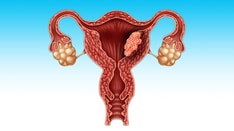This transcript has been edited for clarity.
How should we respond when endometrial biopsy for postmenopausal bleeding reveals proliferative changes?
A 59-year-old woman with a BMI of 32 and who does not use menopausal hormones presents with uterine bleeding. Endometrial biopsy reveals proliferative changes.
This patient represents a clinical scenario often encountered by women's health clinicians. In menopausal women, we have traditionally responded to histopathology demonstrating proliferative changes by reassuring the patient that the findings are benign and advising that she should let us know if bleeding recurs.
However, a recent review published in ACOG's Green Journal details the implications of proliferative endometrial changes in menopausal patients, making the case that treatment as well as monitoring may be indicated.
In premenopausal women, proliferative endometrial changes result from ovarian estrogen production during what we call the proliferative phase of the menstrual cycle. In menopausal women not using hormone therapy, proliferative endometrial changes reflect aromatization of androgens by adipose and other tissues into estrogen.
As in those diagnosed with endometrial hyperplasia, menopausal women found to have proliferative changes are at increased risk for endometrial cancer.
A retrospective cohort study of almost 300 menopausal women found to have proliferative changes with endometrial biopsy, and not subsequently treated, followed participants for an average of 11 years.
The mean BMI of the cohort was 34. The likelihood that women initially found to have proliferative changes were subsequently diagnosed with endometrial hyperplasia or cancer was almost 12%, some four times higher than for women initially found to have atrophic endometrial changes.
We know that oral progestin therapy and follow-up endometrial sampling are effective in preventing endometrial cancer in women diagnosed with the premalignant condition hyperplasia. In recent years, we have also recognized that the convenience as well as the high endometrial progestin levels achieved with levonorgestrel IUDs have advantages over oral progestin therapy in treating endometrial hyperplasia.
Although both oral and intrauterine progestins are highly effective in treating simple hyperplasia, progestin IUDs are substantially more effective than oral progestins in treating complex hyperplasia. The side effects (bloating, unpleasant mood changes, increased appetite) are more common with oral than intrauterine progestin therapy.
Unfortunately, we lack data from randomized trials of progestin treatment among menopausal women with proliferative endometrial changes.
The author of this review suggests that when endometrial biopsy reveals proliferative changes in a menopausal woman, we should perform surveillance endometrial sampling every 3-6 months after initiating progestin treatment. If such sampling reveals benign, but not proliferative, endometrial changes, progestin therapy can be stopped and endometrial biopsy repeated if bleeding recurs. To me, this is sound advice.
I am Andrew Kaunitz. Please take care of yourself and each other.
Follow Medscape on Facebook, Twitter, Instagram, and YouTube
Medscape Ob/Gyn © 2023 WebMD, LLC
Any views expressed above are the author's own and do not necessarily reflect the views of WebMD or Medscape.
Cite this: Treat or Watch? Sound Advice on Postmenopausal Bleeding - Medscape - Mar 21, 2023.
















Comments